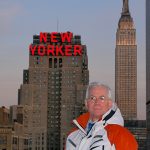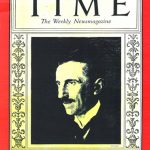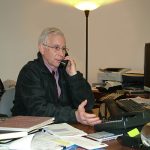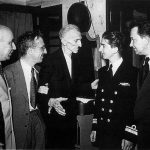September 20, 2009
Travel Through Time in Tesla’s Room
Nikola Tesla spent the last ten years of his life, from 1933 to 1943, in Room 3327 of the New Yorker Hotel. Joe Kinney, an employee of the hotel, is soon to announce plans to set up a small museum in the hotel with an important part of it dedicated to Nikola Tesla.
Many books, studies and novels have been written about Nikola Tesla, and the significance of his discoveries has now reached world-wide dimensions. Many details from his personal life have been interpreted and accounted for, but the possibility always exists that yet another piece will be added to this mosaic. That is how the story about the last years of Nikola Tesla’s life, which he spent in NYC, in the New Yorker Hotel, came about.
Tesla came to New York in 1884, sporting only his dreams and a desire to change the world. And change the world is what he did. He lived and worked in the USA for almost six decades. During that time, he resided in numerous hotels, though the New Yorker Hotel in mid-Manhattan was Tesla’s last home. He lived in Room 3327 from 1933 to 1943, and this is also where he died on January 7, 1943. Three days later, the mayor of New York, Fiorello LaGuardia, delivered the eulogy written by Louis Adamic that was broadcast on New York Radio, with Zlatko Baloković’s performance of “Ave Maria” playing in the background, followed by the popular Serbian song “Tamo Daleko” which Tesla had loved.
An excerpt from the eulogy read by Mayor LaGuardia:
“Here in New York, in his hotel room, a man died. His name was Nikola Tesla. Although he died a poor man, he was one of the most successful men ever to have lived. His successes are enormous, and they will be greater and greater as time goes by. Nikola Tesla could have had hundreds of millions of dollars. He could have become the richest man in the whole world – had he wanted that. He had no time for what others consider success. While he lived, he performed many scientific wonders. Simply put, he served mankind, and for those services he asked for absolutely nothing for himself. Money – he did not care about it. He did not expect gratitude from people. He did not expect a reward for what he had done for mankind. That man is now dead. His tired body is leaving us. However, Tesla still lives in his inventions, they are all deeply ingrained in our civilization…”
Today, 66 years later, another American, Joe Kinney, employed at the New Yorker Hotel, speaks to Business Magazine about Nikola Tesla, Tesla’s Room in the New Yorker Hotel and the great interest in Tesla that continues today. Kinney said:
“Until recently, Room 3327 was no different from any other room in our hotel. We started working on a special ‘Tesla’s Room’ in April 2009. We realized that publicizing the story of this room might be a good advertising move, and we think that next year there will be even more visits. Those staying in this room are divided into three categories. The first are engineers and technological enthusiasts, the second are people interested in UFOs, time travel and telepathy, and the third are Serbs and Croats.”
Spending the night in this room, depending on the season, costs from $150 to $250, the same as for other rooms of the same category. Joe Kinney noted that in May this year they had a request by a famous film star to stay in Tesla’s Room. “Making a movie on Tesla might be in the works, we’ll see…” Kinney observed furtively.
In 2007, Božidar Djelić, the Serbian Deputy Prime Minister, resided in Tesla’s Room and presented Joe Kinney with an autographed copy of his book, “Serbia: Things Will Get Better.”
“We are planning to set up a small museum in the hotel and an important part of it will be dedicated to Nikola Tesla. We would like to procure some exhibits from Tesla’s museum in Belgrade so that we can display them here. The large number of tourists coming to NYC will be able to become better acquainted with this science genius,” our collocutor said.
Kinney reminded us that when Tesla became a permanent resident of the New Yorker Hotel, his fame had already started to decline. Nevertheless, Tesla was visited in the hotel by his relatives and by journalists coming to interview him. Of course, there is the famous photo of King Peter II Karadjordjević taken on July 8, 1942, when he visited Tesla.
Tesla was also visited by representatives of the Westinghouse Company following his car accident in 1937, at the age of 81. Recollecting what Tesla had done for their company, they decided to foot all his expenses for the rest of his life. Tesla also received a pension from the exiled Royal Government.
Asked how he would describe Tesla, Joe Kinney said:
“Tesla was a man who has made a unique technological contribution to society. However, considering that his contribution to society was more important to him than helping himself, he died quite alone. Now he is becoming more and more famous and recognized. As is the case with many great composers and painters, history will appreciate him more than his contemporaries ever did and will have higher respect for him than when he was alive. The other aspect of the story about Tesla is his multiple talent: he was a first-rate mechanic and technician who was always perfecting his skills. He was also an outstanding inventor and researcher who has made huge advances for science by using conventional methods in his research. In addition, he was a visionary and a dreamer with flashes of ideas for immense technological advancements. Likewise, he was a great showman and educator who impressed both professionals and ordinary viewers with some fantastic demonstrations of his achievements.”
Historical Personage
What do you consider to be Tesla’s greatest discovery? Joe Kinney said:
“The greatest invention of Nikola Tesla was – Nikola Tesla. He revealed himself to the world and, as such a visionary, served as an example, being more unique and valuable than any of his discoveries. When history is able to truly understand Tesla, he will be remembered not only for his inventions and patents, but also for his personality.”
Kept from Oblivion
Owing to Joe Kinney’s astute personal involvement and the patronage of the hotel management, today there is a Tesla’s Room in the New Yorker Hotel.
Joe Kinney was born in 1950 in Nashville, Tennessee. He first found out about Nikola Tesla in elementary school, where he and his fellow students learned about electricity and constructed Tesla’s induction coil. He graduated in biology from the Christian Brothers University in Memphis, Tennessee in 1972. He began working for the New Yorker Hotel in July 1996. Today his position is that of Senior Project Engineer.
Joe Kinney is a man who sincerely admires Tesla’s scientific and engineering achievements. He has acquired much of his knowledge about Tesla at the hotel where he works, as well as by having the privilege of being able to visit Tesla’s Room whenever it is available. The hotel also retains Tesla’s photographs taken between 1933 and 1943. Joe Kinney is a Board Member of the Tesla Memorial Society in New York. (http://www.teslasociety.com)
Happy Birthday, New Yorker Hotel!
”The New Yorker Hotel is celebrating its 80th birthday on January 2, 2010, but plans for a celebration have not yet been made,” Joe Kinney noted for Business Magazine.
The hotel was opened on January 2, 1930. It consisted of 43 floors and 2,500 rooms, two big ballrooms, 10 private dining rooms, five restaurants and 35 chefs. The barbershop at the New Yorker was the biggest in the world, with 42 chairs and 20 manicurists. The construction of the hotel cost $20 million. Today there is a commemorative plaque on the hotel stating that Nikola Tesla lived and died there at the age of 87. The plaque was placed with the aid of Dr. Ljubo Vujović, Secretary General of the New York branch of the Tesla Memorial Society, and the Serbian Orthodox Church, on July 10, 2001, the anniversary of Tesla’s birth.
The hotel that was once synonymous with first-class luxury, where popular baseball star Joe DiMaggio and Senator John F. Kennedy stayed, as well as the boxer Muhammad Ali, the Cuban leader Fidel Castro and many others, wishes to regain its former fame and glory. More recently, one of the hotel ballrooms was used by Senator Hilary Clinton in her February 2008 presidential election campaign, and the hotel underwent an impressive $65 million renovation that was completed at the end of 2008.
Author: Marina Bulatović
Photo by: Budislav Bulatović and the New Yorker Hotel Archive
Published in Serbia and Canada: Business Magazine, Culture Bridge Magazine



